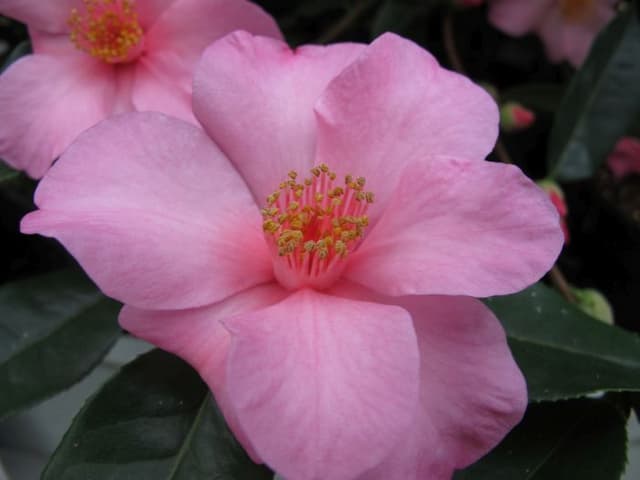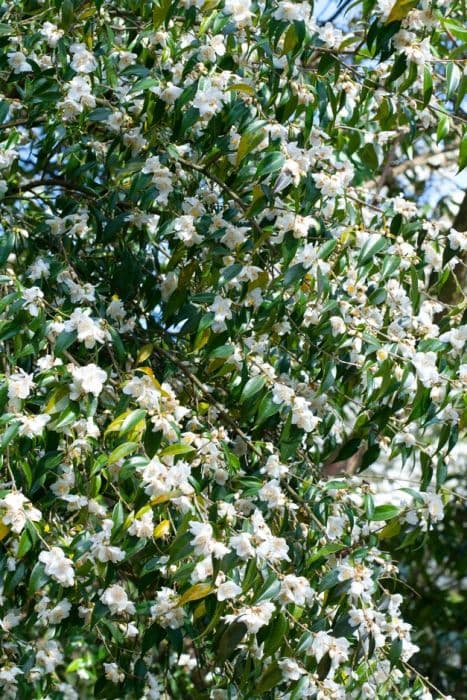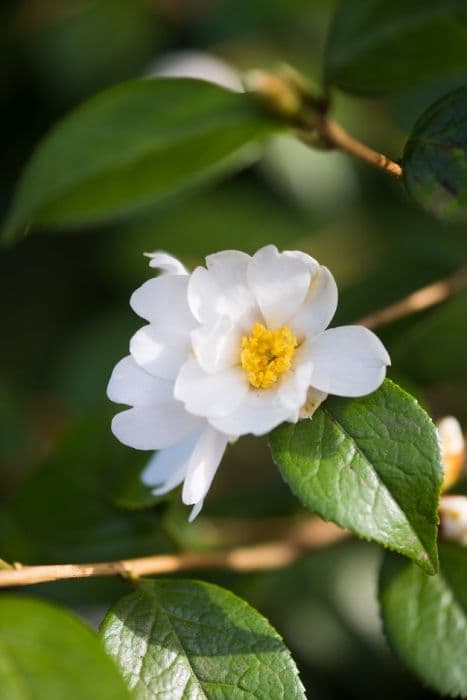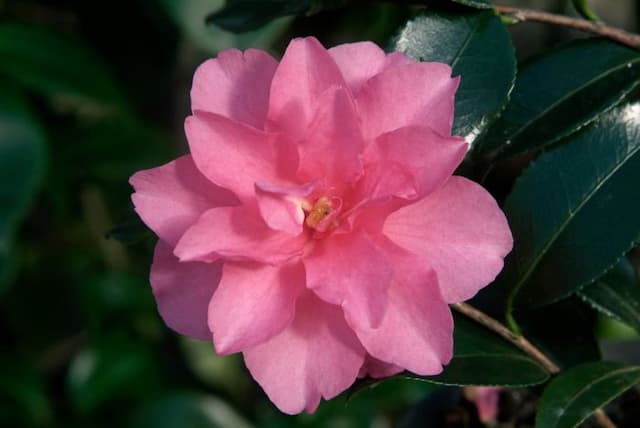Camellia 'San Dimas' Camellia japonica 'San Dimas'

ABOUT
'San Dimas' has a compact, bushy habit and dark red semi-double flowers with a prominent central boss of golden stamens
About this plant
 Names
NamesFamily
Theaceae
Synonyms
Japanese Camellia, Camellia, San Dimas Camellia
Common names
Camellia japonica 'San Dimas'.
 Characteristics
CharacteristicsLife cycle
Perennials
Foliage type
Evergreen
Color of leaves
Dark green
Flower color
Pink
Height
6-10 feet (1.8-3 meters)
Spread
5-8 feet (1.5-2.4 meters)
Plant type
Shrub
Hardiness zones
7
Native area
Japan
Benefits
 General Benefits
General Benefits- Aesthetic Appeal: Camellia japonica 'San Dimas' is known for its beautiful, showy flowers that add a splash of color to gardens and landscapes.
- Year-Round Interest: This variety provides visual interest throughout the year with its glossy evergreen foliage and winter-to-spring blooming period.
- Shade Tolerance: Camellias can thrive in partial shade, making them suitable for understory planting or shaded garden areas.
- Drought Resistance: Once established, Camellia japonica 'San Dimas' has good drought tolerance, requiring less frequent watering.
- Low Maintenance: Camellias generally require minimal pruning and maintenance, making them an ideal choice for low-effort landscaping.
- Longevity: Camellias are known for their long lifespan, with some specimens living for over a century.
- Versatility: Suitable for a variety of landscape applications, including hedges, specimen plants, and container gardening.
- Attracts Pollinators: The flowers of Camellia japonica 'San Dimas' can attract bees and other pollinating insects, benefiting the local ecosystem.
 Medical Properties
Medical PropertiesThis plant is not used for medical purposes.
 Air-purifying Qualities
Air-purifying QualitiesThis plant is not specifically known for air purifying qualities.
 Other Uses
Other Uses- Floral Arrangements: Camellia flowers, including those of Camellia japonica 'San Dimas', are used in floral arrangements due to their vivid colors and beautiful forms.
- Photography Subject: The striking blooms of 'San Dimas' serve as a favored subject for photographers and artists, often featured in botanical art.
- Luxury Bath Products: The petals and oils of 'San Dimas' may be incorporated into bath bombs and luxury soaps for their fragrance and aesthetic appeal.
- Edible Decorations: The petals of Camellia japonica 'San Dimas' are sometimes used to adorn cakes and desserts as an edible decoration.
- Tea Production: In some instances, leaves from Camellia japonica 'San Dimas' could be used as a novel ingredient in artisanal teas.
- Botanical Studies: This variety may be studied by horticulturists and botanical gardens to better understand hybridization and flower development in camellias.
- Cultural Symbols: In certain cultures, 'San Dimas' camellias could be gifted as symbols of love, affection, or admiration due to their beautiful blooms.
- Wedding Decor: Camellia japonica 'San Dimas' flowers are sometimes used in wedding bouquets and venue decorations for their romantic appearance.
- Scented Candles: The fragrance of 'San Dimas' camellias can inspire scented candles that aim to capture the essence of this elegant flower.
- Marking Seasons: The bloom time of Camellia japonica 'San Dimas' can be used by enthusiasts to mark and celebrate the transitions between seasons, especially winter to spring.
Interesting Facts
 Feng Shui
Feng ShuiThe plant camellia is not used in Feng Shui practice.
 Zodiac Sign Compitability
Zodiac Sign CompitabilityThe plant camellia is not used in astrology practice.
 Plant Symbolism
Plant Symbolism- Desire or Passion: The Camellia japonica, commonly known as the Japanese Camellia, often represents desire or deep passion. This symbolism is attributed to the rich and vivid colors of its blooms, which convey strong emotions.
- Admiration: Gifting a Camellia is a way to express admiration towards someone, as its beauty and perfection are qualities that are often admired.
- Perfection: The Camellia's lush petals and orderly form are symbols of perfection and are often associated with the idealized beauty in nature.
- Longevity & Faithfulness: Camellias are known for their long-lasting flowers and the plant's ability to live for many years, symbolizing the endurance of love and the faithfulness between partners over time.
- Refinement: The elegance of the Camellia bloom is often linked with refinement and is considered a symbol of sophistication and the finer things in life.
 Water
WaterJapanese Camellia should be watered deeply to ensure the roots have adequate moisture, typically once a week, allowing the top inch of soil to dry out between waterings. During the growing season in spring and summer, water with about 1-2 gallons per week, depending on the size of the plant and environmental conditions. Decrease watering in the fall and minimize it in the winter when the plant is dormant. If you are growing it in a pot, ensure that excess water can drain to prevent root rot.
 Light
LightJapanese Camellia thrives in partial shade, benefiting from morning sunlight and afternoon shade. The ideal spot is an east-facing location where it can receive gentle morning light but avoid the harsh midday sun. Filtered sunlight beneath high-canopy trees is also suitable, protecting the leaves from sunburn while providing enough light for healthy growth.
 Temperature
TemperatureJapanese Camellia prefers a temperate climate with temperatures ideally ranging between 60°F and 80°F. It can handle minimum temperatures down to around 20°F but may be damaged by prolonged exposure to freezing conditions. During hot summer days, shield the plant from temperatures that exceed 85°F to prevent stress.
 Pruning
PruningJapanese Camellia should be pruned to maintain shape, remove any dead or diseased branches, and encourage airflow within the canopy. The best time to prune is right after it finishes blooming, which is typically late winter or early spring. Pruning at this time ensures that you won't cut off next year's buds, which form shortly after the flowers fade.
 Cleaning
CleaningAs needed
 Soil
SoilThe Japanese Camellia 'San Dimas' thrives best in acidic soil with a pH between 5.5 and 6.5. A good soil mix consists of 1/3 organic material like peat moss or leaf mold, 1/3 garden soil, and 1/3 perlite or vermiculite for drainage.
 Repotting
RepottingJapanese Camellia 'San Dimas' should be repotted every 2-3 years, ideally in spring or autumn, before or after the blooming season, to prevent disrupting its growth cycle.
 Humidity & Misting
Humidity & MistingJapanese Camellia 'San Dimas' prefers high humidity levels, around 50-60%, similar to its native environment in East Asia. Consistent humidity is key for optimal growth and bloom.
 Suitable locations
Suitable locationsIndoor
Provide bright, indirect light and high humidity for indoor Japanese Camellias.
Outdoor
Plant in partial shade and sheltered location for outdoor Japanese Camellias.
Hardiness zone
7-9 USDA
 Life cycle
Life cycleCamellia japonica 'San Dimas', commonly known as the Japanese camellia, begins its life cycle when a seed germinates in suitable soil conditions, often in partial to full shade with slightly acidic, well-drained soil. After sprouting, the seedling stage is characterized by the emergence of the first sets of true leaves, establishing a root system and beginning photosynthesis. The vegetative stage follows, during which the plant undergoes significant growth, producing a woody stem and a lush canopy of glossy, evergreen leaves; this stage can last for several years as the plant matures. As the Japanese camellia reaches maturity, usually within 2 to 5 years, it enters the flowering stage, producing an abundance of showy flowers — the 'San Dimas' variety typically has a profusion of pink, formal double blooms that appear from late winter to early spring. After pollination, which is often assisted by insects, the plant produces fruit in the form of dry capsules containing seeds, which when mature, disperse to give rise to new plants. The Japanese camellia is a perennial, capable of living and flowering for many years, sometimes even centuries, with proper care and favorable conditions.
 Propogation
PropogationPropogation time
Spring to Summer
The Camellia japonica 'San Dimas', commonly known as the Japanese camellia, is typically propagated using semi-hardwood cuttings. This technique is performed during the late summer when new growth has begun to mature and harden slightly. Select a healthy stem of about 4 to 6 inches (10 to 15 centimeters) in length, making a clean cut below a leaf node. Remove the leaves from the lower half of the cutting and dip the cut end into a rooting hormone to promote root development. The treated cutting is then placed in a well-draining potting medium, such as a mix of peat and perlite, and kept under high humidity and indirect light until roots have formed, which could take several weeks to a few months. Maintaining a stable temperature around 70 to 75 degrees Fahrenheit (21 to 24 degrees Celsius) is crucial for successful rooting.









